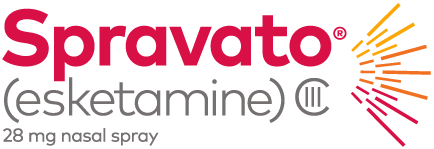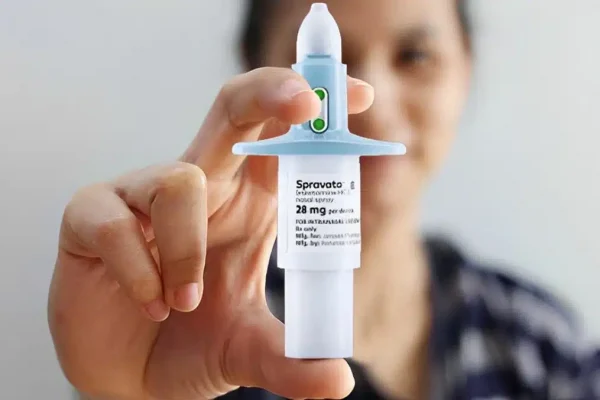Compassionate Care
Now, more options for treatment-resistant major depression disorder
Most current antidepressants work on monoamine neurotransmitters in the brain, such as serotonin, norepinephrine, and dopamine, which are involved processes such as emotion and memory. Ketamine’s action is different, changing the way depression is viewed.
Learn more about Ketamine >>
SPRAVATO®, the only FDA-approved nasal spray for adults with treatment-resistant depression, reduces depression symptoms when two or more oral antidepressants haven’t worked.


Spravato is the brand name for esketamine, a medication used to treat treatment-resistant depression.
It is administered as a nasal spray and can be effective in reducing symptoms of depression, even in patients who have not responded to other forms of treatment.
it can rapidly improve symptoms, even in individuals who have not responded to other forms of treatment.
To receive your Ketamine Infusion Treatments at Wayne Behavioral, you will come to our specialty room located in our main offices. The entire process will be complete 90 minutes after your treatment appointment begins. You will leave experiencing no side effects, however, patients are NOT allowed to drive after an infusion, so you must arrange for transportation with a caregiver or car service.

(973) 790-9222
Call Wayne Behavioral Service to make an appointment for personalized treatment for PTSD.
Ketamine is a medication consistently used as a surgical anesthesia for more than 50 years with children, adults, and animals. Researchers later became aware of ketamine’s ability to relieve depression, anxiety, and some pain disorders in less than 24 hours after administration. Ketamine therapy, administered by qualified medical professionals, is now helping patients with major depression, bipolar depression, PTSD, and pain syndromes such as Complex Regional Pain Syndrome (CRPS) or Reflex Sympathetic Dystrophy (RSD), to rapidly experience relief of their mental and physical symptoms, improving both mood and function – and producing hope.
Ketamine is used to treat depression, suicidal thoughts, PTSD, and nerve-related pain.
Small doses of ketamine are carefully administered by medical professionals in a series of slow intravenous (IV) infusions. These small doses of ketamine have very different effects on the body than when it is taken in large doses, as during surgery or when it is when illegally used as a “party drug.” Your doctor will determine if you are a suitable candidate for ketamine therapy.
70-80% of those receiving a ketamine treatment experience symptom relief within the following 24 hours. Ketamine quickly metabolizes and is clear of the body within 24 hours of administration, but the symptom relief can last for days, weeks, or even months. Ketamine is not a permanent fix, however. For continued relief, booster treatments are needed. The length of time between these booster treatments varies depending on individual responses.
Ketamine therapy patients generally report experiencing an out-of-body response during the administration of the drug, which usually wears off within 30-60 minutes post-infusion. Other side effects may include changes in heart rate or blood pressure, confusion, or nausea. Side effects usually subside before being released from the office after a treatment.
The low doses of ketamine used in therapy, especially administered in a medically supervised setting, eliminate virtually all potential for addiction or abuse. For the duration of a ketamine infusion, blood pressure and heart rate may increase – therefore patients with uncontrolled blood pressure, unstable heart disease, untreated thyroid disease should not use ketamine. People with active substance abuse, active psychosis, or patients who are currently experiencing the manic phase of bipolar disease also should not use ketamine treatments. Ketamine is contraindicated during pregnancy. Patients undergoing treatments are monitored closely to ensure safety during the acute course. Long-term safety studies of repeated ketamine infusions have not been published.
Some medications interfere with ketamine, and you should talk to your doctor about all medications you are taking before starting treatment.
For 70-80% of patients treated, ketamine provides a break from debilitating symptoms of depression within 24 hours of a ketamine treatment, but it is not a permanent cure. These breaks last different lengths of time for each individual and can range from a day to months at a time. Booster treatments can be given to extend the symptom relief.
To maximize your treatment results, follow through on other methods of treatment for your depression during the breaks ketamine treatments provide. Because of the repairs made to the communication systems in your brain, psychotherapy, or talk-therapy, is often more effective at this point.
Not at this time. Ketamine is not FDA approved for treating depression; therefore, it is considered “off-label use” and not covered by insurance. However, the new information provided by research into ketamine’s treatment of depression has inspired research into an entirely new category of drugs, requiring a fresh understanding of how depression works on the brain.
If you are interested in Ketamine Therapy for you or a loved one, please call us. We would be happy to help you determine whether Ketamine Therapy is right for you.